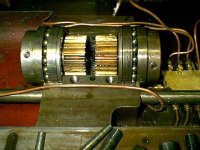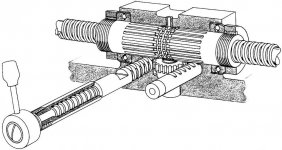From your initial post, I imagine you are delving into the design of anti-backlash mechanisms as a design exercise or research project rather than to build a working machine tool. I could be wrong and it would not be the first time.
A type of spring which could be "stacked" concentric with the feed nuts is the "Belleville Washer". These are truncated cones of spring tempered steel. They can be used singly or stacked as needed. An interesting application of the Belleville Washer is found in what is known as a "Limitorque" operator. This is a motor with reduction gearing and limit switches used to open and close large valves, sluice gates, and similar application. As the name says, the distinguishing feature of this device is the ability to "Limit Torque", hence the name. A Limitorque operator utilizes helical gears for the primary and intermediate speed reduction from the drive motor. Final drive to the stem nut or shaft of whatever is being actuated is by a hardened steel worm and bronze worm gear. The primary means of controlling a Limitorque operator are position limit switches. The final protection is the torque limiting feature. This is accomplished by taking the end thrust of the worm on the final drive with a "pack" of Belleville washers. If the gate or valve should "hard seat" on some debris in the flow passage or experience a mechanical bind, the torque applied to the worm gear increases correspondingly, and the end thrust developed by the worm increases as a result. When the end thrust overcomes the setting on the Belleville Washers, the worm screws itself out of engagement and trips a final electrical limit switch, taking out the motor.
The interesting part of this is the fact the Belleville Washer packs can be ordered in precise end thrust (which Limitorque correlates into output torque ranges). A further fine-tuning of the maximum torque is had by an adjusting screw to set the deflection on the Belleville Washers. I've been quite impressed by the ingenious mechanism and the use of something so simple but "elegant" (as engineers like to say).
Belleville Washers, set concentric with the feed screw, and having a threaded adjusting collar, could be used to adjust backlash and add some "preload" on the feed nuts. However, there is a trade-off. Pre-load produces friction and tends to squeeze out the lubricant from the feed nut/feed screw thread flanks.
On the Limitorque Operators, I've seen a lot over the years. We had six of them on some floodgates on a dam. These had stems with Acme threads cut in 3 1/2" diameter 300-series stainless steel. Think of a lead screw about 15 feet long. What used to happen with some reqularity was a stripping out of the stem nuts. Imagine a chunk of aluminum bronze about 6 inches in diameter x maybe 12 inches long with a 3 1/2" internal Acme thread and drive splines milled on the outside. We were caught between a rock and a hard place: if we lubricated the stem threads with grease capable of resisting the high pressures, the grease, when immersed down into the river water, was a perfect trap for waterborne grit and small debris. This stuff made it up into the stem nuts and in a matter of 6 to 12 operating cycles, we had knife edged threads in the stem nut. If we did not lubricate the stem threads with grease, but sprayed them with a hose to clean off the river-borne grit and debris and then applied a thin lubricant manually, the stem nuts lasted a bit longer. Another side-effect of using heavy bodied grease on the stem threads in winter weather (out on the dam, no enclosure or heat) was increased drag. During high water/flood stage conditions when the hydraulic loads on those gates was at its maximum, we actually wore out some of the bronze worm gears ahead of the stem nuts.
We also learned that the torque limit setting could be very finely adjusted to almost a "razor edge" thanks to those Belleville Washers. As I said, I've seen some hellacious damage due to a lack of lubrication on what are known as "power transmission threads". A feed screw in a milling machine is a smaller version of this. On the flood gates, when the gates were opening or closing, there is a range when the gate has a relatively small opening in which what is known as "hydraulic downpull" occurs due to throttling thru the gate and discharging water freely into the open on the downstream side. In addition to this "downpull", which puts the maximum load on the stem and nut, there is some "chatter" of the gate leaf (think of about 15 tons of cast iron, edges faces with bronze, able to be raised and lowered in guides under the water). The chatter of the gates would be so bad it would literally pound the bronze seating surfaces, cold working them until they split. Add the hydraulic force from the head of the water pushing the gate into its seat with resulting friction drag. The forces and things that happen to a sluice gate and its stem and operator were quite a set of lessons for me.
I can appreciate your wanting to design a "perfect" feed screw and nut for milling machine tables. However, going back to your analogy of the saddle, there are as many ways (and maybe more) of designing this anti-backlash mechanism as there are (or were) machine tool builders. All were designed to accomplish the same thing. I do not think any design ever resulted in the ideal of "zero backlash". We learned to live with what we had on those flood gates, and kept Cardish Machine Works busy from time to time making more stem nuts. I would have to say that once the ball screw system was perfected and came into common use, the quest for the better anti backlash design quietly faded away, not to mention the numerous builders of manual milling machines who similarly and sadly also faded into oblivion.
You simply can't have "zero backlash" with a conventional screw and nut. There HAS to be some slight clearance to avoid clamping the screw onto the nut, and to allow a film of lubrication. Once that is established, backlash, however slight, is a given. The trick is keeping backlash in workable limits to allow climb milling. As I said, I've used older and worn mills with a half turn of backlash in the X axis feed screw due to worn nuts. Despite that, I worked to the thousandth with no problem. If you work on machine tools, you learn to "take up the backlash" as a routine thing. If you work on worn older machine tools, you also learn how to deal with "stick slip" friction in the sliding surfaces when needing to take a fine finishing cut or make a very small adjustment to table position. A nice tight machine tool is sheer pleasure and a joy to work on, no question about it. But, in the real world, we had to work on what we had, where getting a job done was the main thing, not repairing someone else's worn out machine tools with materials and parts we did not have.
As I wrote, the idea of using Belleville Washers in a "pack" concentric with the feed screw to provide a very precisely controlled "preload" to the feed nuts is something I'd explore if I were designing and anti backlash mechanism. It is "simple but elegant".


 . No doubt there are other designs out there.
. No doubt there are other designs out there.







